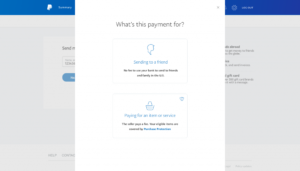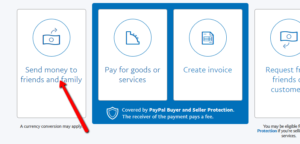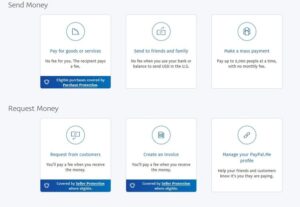Ever found yourself in a situation where you’re scratching your head, wondering how to get money back from PayPal Friends and Family transactions? Trust me, we’ve all been there, and maybe the item you purchased online didn’t quite meet expectations, or plans changed, and suddenly that payment needs a U-turn.
In this guide, we’re going to unravel the mystery behind retrieving funds from PayPal Friends and Family. We’ll talk about the quirks and limitations of this payment method, and more importantly, spill the beans on potential avenues for getting your money back.
So, if you’re stuck in a tech hiccup, had a change of heart, or just need to sort out a payment mix-up, we’ve got your back.
Understanding PayPal Friends and Family

It’s that friendly-sounding feature that simplifies splitting bills or sending money to your pals hassle-free. But wait, there’s a twist. Unlike regular transactions, this one lacks the buyer protection safety net. So, what’s the deal with PayPal Friends and Family, and how does it work?
Think of it like a digital IOU between buddies. It’s designed for those casual transactions, where you’re picking up the dinner tab or contributing to a group gift. It skips the fees you’d find in a business transaction, making it appealing for personal exchanges.
Now, here’s the catch because it’s meant for friends and family, it comes with fewer safeguards. Once you hit that “send money” button, there’s no buyer protection to bail you out. That’s cool when everything goes as planned, but what if you change your mind, or a deal sours?
And this is where things get interesting. Navigating the world of PayPal Friends and Family refunds isn’t as straightforward. The system is designed for trust among acquaintances, but let’s face it, life happens, plans change, and misunderstandings occur.
How to get money back from paypal friends and family
It’s important to note that PayPal Friends and Family transactions are designed for personal, non-commercial transactions, and they come with limited buyer and seller protection. When you send money using the Friends and Family option, it is usually considered a gift, and PayPal doesn’t offer the same dispute resolution mechanisms as they do for goods and services transactions.
If you’ve sent money through PayPal Friends and Family and you want to get it back, your options may be limited, and it largely depends on the willingness of the person who received the money to refund it. Here are some steps you can take:
- Contact the recipient:
- Reach out to the person who received the money and explain the situation. Politely ask if they would be willing to refund the payment.
- Open a dispute (if eligible):
- Log in to your PayPal account.
- Go to the Resolution Center.
- Click on “Report a Problem.”
- Select the transaction you want to dispute.
- Follow the on-screen instructions.
Keep in mind that PayPal’s Buyer Protection typically applies to goods and services transactions, not Friends and Family payments. However, it’s worth checking if you can open a dispute.
- Contact PayPal support:
- If the recipient is unresponsive or unwilling to refund, you can contact PayPal customer support and explain the situation. While there’s no guarantee of success, they may be able to offer guidance or assistance.
Remember, it’s crucial to use the appropriate PayPal features for the type of transaction you’re engaging in. If you need the added protection that comes with buyer and seller protection, consider using the Goods and Services option, even if there’s a small fee associated with it.
Always be cautious when sending money online and make sure you understand the terms and conditions associated with the payment options you choose.
Reasons for Seeking Money Back

People may seek to get their money back for various reasons, depending on the context of the transaction or the service/product they received. Here are some common reasons why someone might want a refund or to get their money back:
- Defective or Substandard Product:
- If a purchased product is defective, damaged, or does not meet the advertised specifications, a buyer may request a refund.
- Unsatisfactory Service:
- In the case of services, if the service provider fails to deliver the promised service or does not meet the customer’s expectations, a refund might be requested.
- Cancellation of Order or Service:
- If a customer decides to cancel an order or service before it is fulfilled, they may seek a refund. The refund policy will depend on the terms and conditions set by the seller or service provider.
- Unauthorized Transactions:
- If there are unauthorized transactions on a person’s account, they may seek to get their money back. This could be due to fraud, hacking, or other security issues.
- Double Payment or Overcharge:
- In some cases, customers may be charged more than once for the same transaction, or they may be overcharged. In such situations, they may request a refund for the excess amount.
- Misrepresentation or Fraud:
- If a buyer feels that they were misled or subjected to fraudulent practices during a transaction, they may seek a refund.
- Change of Mind (with Applicable Policies):
- Some sellers or platforms have return policies that allow customers to get a refund if they change their mind about a purchase within a certain period. This is common for online shopping.
- Subscription Cancellation:
- If a customer wishes to cancel a subscription service and is eligible for a refund based on the cancellation policy, they may seek to get their money back.
- Failed Transaction:
- In cases where a financial transaction fails to go through properly or is not completed as expected, the person involved may request a refund.
It’s important for both buyers and sellers to be aware of the terms and conditions of transactions, refund policies, and applicable laws to ensure a fair and transparent process for handling disputes and refund requests.

Tips for a Successful Refund Request
Requesting a refund can sometimes be a sensitive process, but following certain tips can increase your chances of a successful outcome. Here are some tips for a successful refund request:
- Read and Understand the Refund Policy:
- Before making a purchase, carefully read the seller’s or service provider’s refund policy. Be aware of the conditions and timelines for requesting a refund.
- Act Promptly:
- If you encounter an issue with a product or service, don’t delay in contacting the seller or service provider. Many refund policies have specific timeframes within which you must request a refund.
- Provide Clear Documentation:
- Clearly outline the reasons for your refund request and provide any supporting documentation. This may include photos of damaged products, screenshots, or any relevant communication.
- Be Polite and Professional:
- Maintain a polite and professional tone in your communication. Avoid being confrontational or aggressive, as this can hinder the resolution process.
- Use the Appropriate Channels:
- Follow the designated process for refund requests. If there’s a customer support email or a specific online form, use it. This ensures that your request reaches the right department or individual.
- Be Specific:
- Clearly state the issue and specify the resolution you are seeking. Whether it’s a replacement, a partial refund, or a full refund, make it clear in your request.
- Know Your Rights:
- Familiarize yourself with consumer protection laws in your jurisdiction. Understanding your rights can be helpful when negotiating a refund.
- Escalate if Necessary:
- If your initial request is not successful, be prepared to escalate the issue. This may involve contacting higher-level customer support, filing a complaint with relevant consumer protection agencies, or disputing the transaction with your payment provider.
- Maintain Records:
- Keep records of all communication related to the refund request. This includes emails, chat transcripts, and any other relevant documentation. These records can be useful if you need to escalate the issue or if further action is required.
- Be Patient:
- Resolving refund issues may take time. Be patient and allow the seller or service provider the opportunity to investigate and respond to your request.
- Check Payment Provider Policies:
- If the transaction was made through a payment provider like PayPal, familiarize yourself with their dispute resolution process and policies.
Remember that successful outcomes often depend on the specific circumstances and the policies of the seller or service provider. Approach the situation with a clear understanding of your rights and a willingness to work towards a fair resolution.
Conclusion
Navigating the process of getting money back from PayPal Friends and Family transactions necessitates careful consideration and an awareness of the limited recourse available. When dealing with this particular payment method, labeled as “How to get money back from PayPal Friends and Family,” it’s important to recognize the inherent absence of the buyer and seller protections present in goods and services transactions.
While attempting open communication and exploring PayPal’s dispute resolution process are viable options, success is not guaranteed. It is paramount to approach transactions with caution, thoroughly understand PayPal’s policies, and consider opting for the Goods and Services option when added protection is desired. Prevention through informed choices remains the most effective strategy in these situations.
